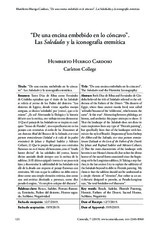Mostrar el registro sencillo del ítem
“De una encina embebido en lo cóncavo”. Las Soledades y la iconografía eremítica
| dc.contributor.author | Huergo Cardoso, Humberto | |
| dc.date.accessioned | 2020-06-03T10:05:35Z | |
| dc.date.available | 2020-06-03T10:05:35Z | |
| dc.date.issued | 2019 | |
| dc.identifier.issn | 2340-8960 | |
| dc.identifier.uri | http://hdl.handle.net/10396/20079 | |
| dc.description.abstract | Tanto Díaz de Ribas como Fernández de Córdoba opinaban que el título de las Soledades se refería al yermo de los Padres del desierto: “Los desiertos de Egipto, donde vivían aquellos monjes antiguos, se decían ‘soledades’ por ‘yermo’, que es lo mismo”. ¿Es así? Alternando la filología y la historia del arte con la estética, este trabajo intenta demostrar: 1) Que el paisaje de las Soledades no se inspira en cualquier “lienzo de Flandes”, sino específicamente en los paisajes con ermitaños al estilo de las Tentaciones de san Antonio Abad del Bosco o de la Solitudo, sive vitae patrum eremicolarum (Soledad o la vida de los padres ermitaños) de Johan y Raphael Sadeler y Adriaen Collaert; 2) Que lo propio del paisaje con ermitaños flamenco no es el beatus ille horaciano, sino el “mudo horror divino” de las soledades del yermo, horror divino asociado desde siempre con la estética de lo sublime; 3) El último epígrafe intenta ir un poco más lejos y desentrañar la sublimidad de las Soledades más allá de la deuda con respecto al paisaje flamenco con ermitaños. Mi tesis es que lo sublime no debe entenderse como una simple elevación retórica, sino como una anti-retórica destinada a provocar, como dice pseudo-Longino, “el completo colapso del discurso”. | es_ES |
| dc.description.abstract | Both Díaz de Ribas and Fernández de Córdoba believed the title of Soledades referred to the wilderness of the Fathers of the Desert: “The desserts of Egypt, where those ancient monks lived, were called ‘solitudes’ because of the ‘wilderness’, which means the same”. Is this true? Alternating between philology, art history, and aesthetics this paper attempts to show: 1) That the landscape of the Soledades does not draw its main inspiration from any type of “Flemish painting”, but specifically from that of the landscapes with hermits in the style of Bosch’s Temptations of Saint Anthony the Abbot and the Solitudo, sive vitae patrum eremicolarum (Solitude or the Lives of the Fathers of the Desert) by Johan and Raphael Sadeler and Adriaen Collaert; 2) That the main characteristic of the landscape with hermits is not Horace’s beatus ille, but rather the divine horror of the sacred forests associated since the beginning with the Longinian sublime; 3) Taking a step further, in the last section I try to explain the sublimity of the Soledades beyond its debt to Flemish painting. My thesis is that the sublime should not be understood as a simple rhetoric of “elevation”, but rather as an anti-rhetoric designed to provoke, as Pseudo-Longinus says, “the total breakdown of discourse”. | es_ES |
| dc.format.mimetype | application/pdf | es_ES |
| dc.language.iso | spa | es_ES |
| dc.publisher | UCOPress | es_ES |
| dc.rights | https://creativecommons.org/licenses/by-nc-nd/4.0/ | es_ES |
| dc.source | Creneida 7, 121-167 (2019) | es_ES |
| dc.subject | Bosch, Hieronymus, ca. 1450-1516 | es_ES |
| dc.subject | Sadeler, Raphael, 1561-1632 | es_ES |
| dc.subject | Pintura flamenca | es_ES |
| dc.subject | Ermitaño | es_ES |
| dc.subject | Padres del desierto | es_ES |
| dc.subject | Horror sagrado | es_ES |
| dc.subject | Sublime | es_ES |
| dc.subject | Negatividad | es_ES |
| dc.subject | Flemish painting | es_ES |
| dc.subject | Hermit | es_ES |
| dc.subject | Fathers of the desert | es_ES |
| dc.subject | Sacred horror | es_ES |
| dc.subject | Sublime | es_ES |
| dc.subject | Negativity | es_ES |
| dc.title | “De una encina embebido en lo cóncavo”. Las Soledades y la iconografía eremítica | es_ES |
| dc.title.alternative | “De una encina embebido en lo cóncavo”. The Soledades and the Hermitic Iconography | es_ES |
| dc.type | info:eu-repo/semantics/article | es_ES |
| dc.relation.publisherversion | http://www.uco.es/servicios/ucopress/ojs/index.php/creneida/index | es_ES |
| dc.rights.accessRights | info:eu-repo/semantics/openAccess | es_ES |

